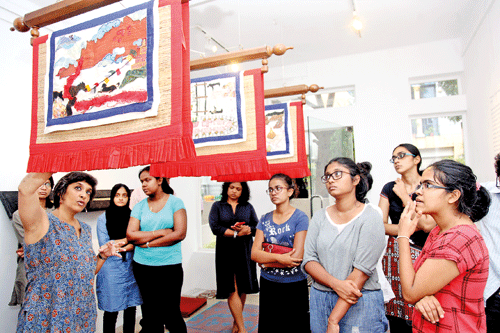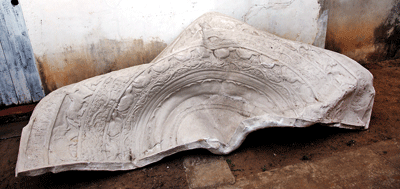2 cultures in artistic dialogue

Dr. Paula Sengupta outlining “The Plain of Aspiration”. Pix by Priyantha Wickramaarachchi
‘A Tale of Two Cities’ – a thought-provoking exhibition that opened on Sunday, August 13 at Theertha Red Dot Gallery, is a collective of the work of 11 well known artists from Sri Lanka and India.
‘A Tale of Two Cities’ was conceptualised to respond to the religious, social, cultural and political nuances of Anuradhapura, a sacred city of Sri Lankan Buddhists, and Varanasi, a holy city on the Ganges, and a place for Hindus and Jains to attain ‘Moksha’ (‘release’ at the moment of death). Lord Buddha delivered his first sermon at nearby Sarnath.
The artists were challenged to cross regional and experimental boundaries in the two-year project, through research of the two varied but similarly contextual environments. The result is a thought-provoking dialogue between cultures.
The project includes Indian artists Manjunath Kamath, Riyas Komu, Manisha Parekh, Ram Rahman, Paula Sengupta and Chintan Upadhyay and Sri Lankan artists Anoli Perera, Pala Pothupitiya, Pradeep Chandrasiri, Bandu Manamperi and Jagath Weerasinghe.
It all came about when Renu Modi, director of Gallery Espace in New Delhi, in search of a city as a counterpart to Varanasi, met Jagath Weerasinghe, Chairman of Theertha Artists Collective. Jagath suggested Anuradhapura. According to Jagath “this exhibition questions the triangular relationship between religion, violence and contemporary democratic politics” which the organisers believed the two particular cities complemented each other in.
Thus, in September 2015, the 11 artists initiated their research in Anuradhapura and in December 2015 visited Varanasi. The first exhibition took place in December 2016 at the Serendipity Arts Festival in Goa and was followed by an exhibition held at the Indira Gandhi National Centre for the Arts (IGNCA) in Delhi in March of this year.
We arrived in the nick of time to hear Indian academic, artist and writer Dr. Paula Sengupta passionately explaining to her enraptured audience of young art students her collection of wooden pankha-holders with woven grass mat and cotton cloth pankha and embroidery hand knitted applique on silk, which she had titled “The Plain of Aspiration”.
Inspired by her Bangladeshi inheritance of ‘Nakshi Kantha’, a type of traditional Bangladeshi embroidered quilt, the design is an amalgamation of Tibetan ‘thangkas’, which is a form of spiritual painting, and Bangladesh pankh – a hand-held fan made of woven squares of bamboo strips.

‘Moonstone-1’: Bandu Manamperi’s creation
“Varanasi and Anuradhapura became another two significant mappings of my Buddhist travels which I have been doing for many years,” she says, adding that she had been following the footsteps of Buddhist pilgrims at the holy sites of South Asia and South East Asia. Her depiction of stupas in Anuradhapura and Buddha’s Wheel of Dharma at Sarnath in Varanasi were in the form of appliques accompanied by an applique of Sigiriya Apsara, a symbol which Paula added as a mark of her presence at these holy sites.
Lankan artist and sculptor, Bandu Manamperi, exhibited a charcoal-filled glass box themed as “Charcoal Journeys” – inspired by the spirituality and violence associated with ashes.This piece was influenced by Angara Stupa, where Lord Buddha’s ashes were deposited and the wooden pyres on the banks of river Ganges in Varanasi along with Sri Lankan eras of political and ethnic violence. His exhibit included a distorted replica of a large fibreglass and resin sculpture of a moonstone (Sandakada pahana) split in to two, titled ‘Moonstone -1’. The sculpture portrayed the iconography of Buddhist philosophy in the sacred sites of Anuradhapura. Manamperi commented “The ashes signify the end of a life similar to the lotus in the middle of the moonstone depicts the Nirvana.”
As quoted in her interview from March 18 of this year with Indian journalist Supriya Sharma from the Hindustantimes.com, Indian artist Manisha Parekh was said to have been struck by the sheer size of the stupas that adorn the grounds of Anuradhapura. Parekh has taken on an abstract watercolour series which she has titled ‘A Chant’ and a second series titled ‘Home Shrine’. The two series are a juxtaposition of each other: ‘A Chant’ embodies the calm Parekh associated with Anuradhapura with its “blue skies and the white on the stupa”,to the hustle and bustle of Varanasi in ‘Home Shrine’ she is quoted as saying in the interview. The artist has captured the essence of this with the help of robust colour palates, distinctively embodying the characteristics of the sacred sites .
The work of the local artists – acrylic paintings by Jagath Weerasinghe to Anoli Perera’s “Geographies of Deliverance”, luminous six-foot tapestries depicting visitors to the Bodhi tree in Anuradhapura, Delhi based photographer Ram Rahman’s contemporary poster series “The Man, the Word, the Tree, the Lotus” that adorn the walls of the gallery all merited closer scrutiny.
‘A Tale of Two Cities’ is presented by the Galle Escape (New Delhi, India), Theertha International Artists Collective (Colombo, Sri Lanka) and Serendipity Arts Trust (India) and was a vision for conceiving artistic perception and conversation which according to the exhibition’s curatoral advisor, Ruhanie Perera, allows the artists to become “provocateurs”.
“A Tale of Two Cities” will continue till September 8, from 10 a.m. to 7 p.m at Theertha Red Dot Gallery – 39/4 A, D.S.Senanayake Mawatha, Borella.
| Today, the 2nd Exhibition Talk & Walk Through with Bandu Manamperi | |
| In line with “A Tale of Two Cities”, the Red Dot Gallery is hosting “Exhibition Talk & Walk Through”, in the first of which we saw artist Paula Sengupta talk with exhibition goers of her work ‘Plain of Aspiration’ and “Discussion”. The second “Exhibition Talk & Walk Through” with artist and sculptor Bandu Manamperi on his sculptural work ‘Moonstone – 01’ and performance work ‘Charcoal Journeys’ will be today at 4 p.m. at the Red Dot Gallery. The talk will be followed by a walk-through the exhibition led by Prasanna Ranabahu – lecturer in Art History and the Theory of Art History at the Post-Graduate Institute of Archaeology. Discussion forums will be held on August 27 at 4 p.m. with Masooma Syed, Pradeep Thalawatte and Pradeep Chandrasiri in conversation on ‘Reading the City | Reading the Sacred’. This discussion is located in a series of lectures on the ‘city’ as a concept and expression in cultural practice conducted by the Theertha School of Arts. On September 3 at 4 p.m. Jagath Weerasinghe will be in conversation with Ruhanie Perera on his work ‘Temporalities of Violence’ and the location of Anuradhapura within the conceptual and curatorial framing of ‘A Tale of Two Cities | India and Sri Lanka’.
|


